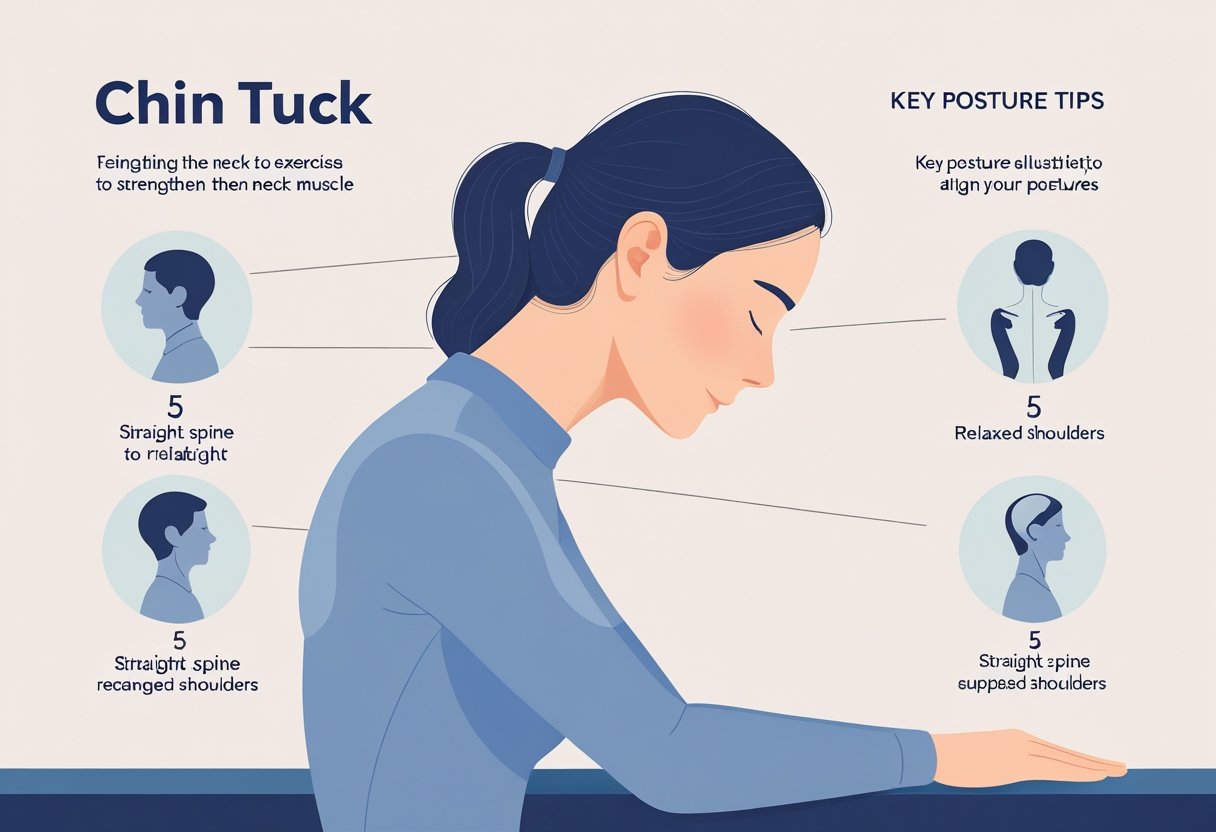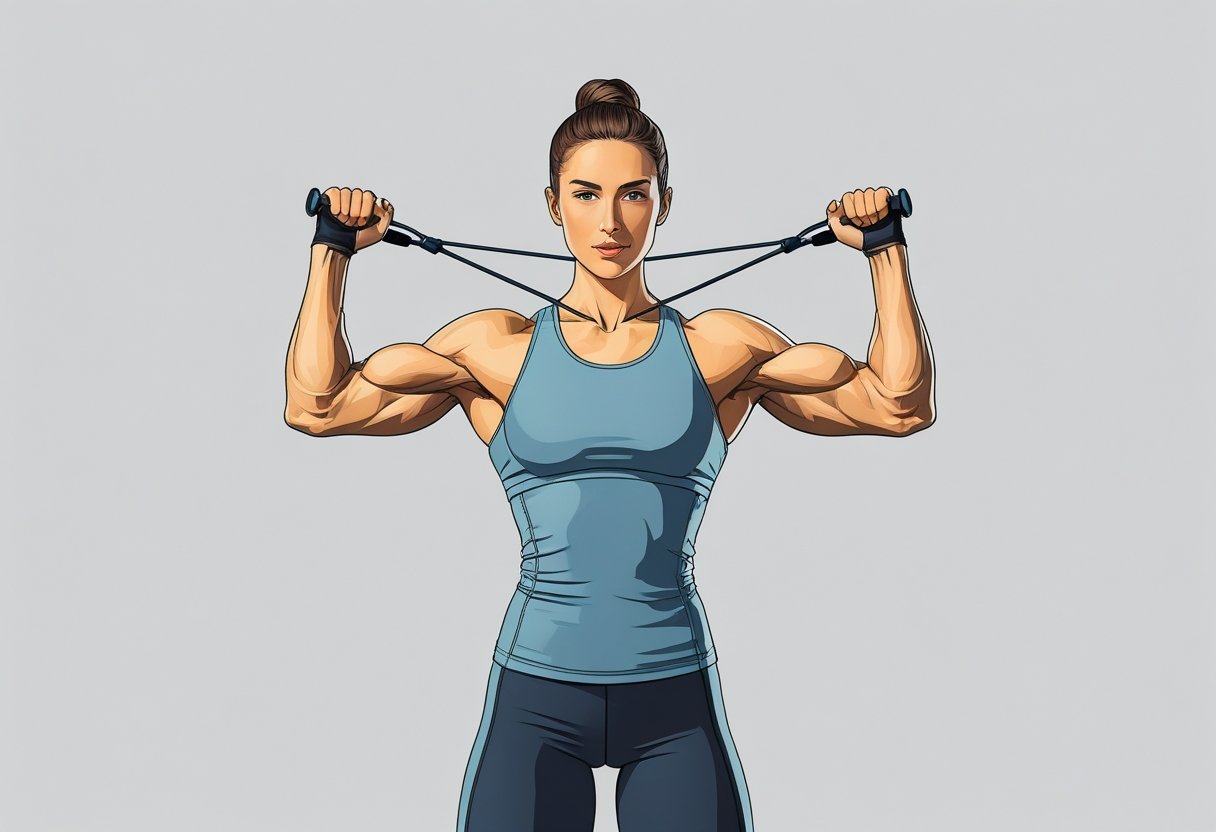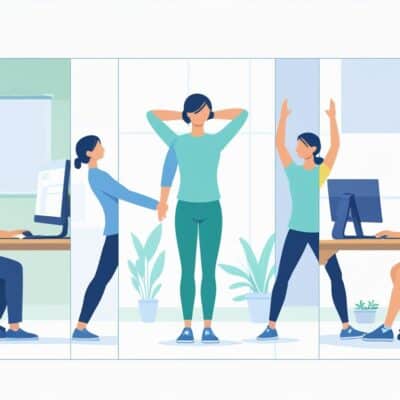Posture affects more than just appearance; it influences comfort, movement, and overall well-being throughout the day. Small adjustments in how someone stands, sits, and moves can create noticeable improvements in how the body feels and functions. Learning simple, practical strategies makes it possible to strengthen key muscles and support the spine more effectively.
This article explores clear, actionable steps that focus on building strength, improving mobility, and creating better support during everyday activities. By applying these methods consistently, anyone can reduce strain, improve alignment, and set the foundation for long-term benefits.
1) Practice chin tucks daily to strengthen neck muscles.

Chin tucks involve gently pulling the chin straight back toward the throat without tilting the head up or down. This small movement activates the deep neck flexor muscles, which play an important role in stabilizing the head and neck.
When performed consistently, chin tucks can help counteract forward head posture that often develops from long hours at a desk or looking down at devices. By reinforcing proper alignment, they reduce strain on the neck and upper back.
The exercise is simple to do in almost any setting. A person can sit or stand upright, keep the shoulders relaxed, and slowly draw the chin back, holding for a few seconds before releasing. Repeating several times a day builds endurance in the supporting muscles.
Research and clinical practice suggest that chin tucks may ease mild neck discomfort and improve posture over time. They are often recommended by physical therapists because they target muscles that are difficult to strengthen with other movements.
Practicing chin tucks daily provides a practical way to strengthen the neck, support better alignment, and reduce the effects of prolonged sitting or screen use.
2) Perform face pulls to target lower traps and rear delts

Face pulls strengthen the muscles that support the upper back and shoulders, especially the rear delts, lower traps, and rotator cuff. These muscles often become weak from long hours of sitting or forward-leaning posture. Strengthening them helps improve alignment and reduces muscular imbalances.
To perform the exercise, a person typically uses a cable machine with a rope attachment set at upper chest or head height. They pull the rope toward the face while keeping elbows high and shoulder blades squeezed together. This motion emphasizes the rear delts and activates the lower traps.
Face pulls also train the stabilizing muscles of the shoulders. By engaging these smaller but important muscle groups, the exercise supports better posture and reduces stress on the joints during other lifts or daily movements.
When added to a regular strength routine, face pulls provide balance to pressing exercises like push-ups and bench presses. This balance helps maintain shoulder health while reinforcing an upright posture.
3) Incorporate thoracic spine stretches to improve mobility
The thoracic spine plays an important role in posture because it connects the upper and lower body. When this area becomes stiff, it can limit shoulder movement and encourage slouching. Regular stretching helps maintain flexibility and alignment.
Simple movements like seated rotations or cat-cow stretches encourage rotation and extension in the mid-back. These exercises can be performed without equipment and fit easily into a daily routine.
Stretching the chest and lats also supports thoracic mobility. For example, a kneeling lat stretch or a doorway pec stretch can reduce tightness that pulls the shoulders forward.
Controlled thoracic rotations on the floor or in a seated position improve spinal movement while keeping the lower back stable. This helps the upper back move more freely without overcompensating elsewhere.
Practicing these stretches for just a few minutes each day can make posture feel more natural and upright. Consistency matters more than intensity, so gentle and regular practice is often most effective.
4) Use a lumbar support cushion when sitting for long periods.
A lumbar support cushion helps maintain the natural curve of the lower spine. By filling the gap between the back and the chair, it reduces the tendency to slump forward. This simple adjustment encourages a more upright sitting position.
When the lower back is supported, less strain is placed on the discs, muscles, and ligaments. This can make sitting for extended periods more comfortable, especially during desk work or driving. It also helps distribute body weight more evenly.
The cushion should not be too large or too small. A cushion that is too big can force the back to arch, while one that is too small may not provide enough support. The goal is to support the spine without altering its natural alignment.
Positioning matters as well. The cushion should rest at the small of the back, just above the hips. Keeping feet flat on the floor and shoulders relaxed further improves posture while using the cushion.
Lumbar cushions are available in different shapes and materials. Choosing one that fits the chair and body type ensures better comfort and effectiveness. Many people find them useful in both office chairs and car seats.
5) Do scapular squeezes to enhance shoulder stability
Scapular squeezes target the muscles that control the shoulder blades. By strengthening these muscles, a person can improve shoulder stability and support better posture.
To perform the exercise, they should sit or stand upright with arms at their sides. Then they gently pull the shoulder blades back and down, holding for a few seconds before releasing.
This movement activates the middle and lower trapezius as well as the rhomboids. These muscles help keep the shoulders from rounding forward, which is a common postural issue.
Scapular squeezes can be done without equipment, making them simple to add into daily routines. They can also be performed at a desk, which makes them practical for people who sit for long periods.
Over time, regular practice may reduce shoulder tension and improve comfort during overhead or pressing movements. Consistency is key, as small daily efforts reinforce better alignment and control.
Understanding the Importance of Posture
Posture influences how the body moves, how muscles and joints function, and how much strain is placed on the spine. Small daily habits, such as sitting or standing positions, can make a measurable difference in comfort and long-term musculoskeletal health.
How Posture Affects Overall Health
Good posture keeps the spine in proper alignment, which reduces unnecessary stress on muscles, ligaments, and joints. When the body is balanced, weight is distributed evenly, lowering the risk of pain in the neck, shoulders, and lower back.
Proper alignment also supports efficient breathing. When the chest and diaphragm are not compressed, the lungs expand more fully, improving oxygen intake and energy levels. This can make daily tasks less tiring.
Posture also affects circulation and digestion. Slouching can compress abdominal organs, which may slow digestion or contribute to discomfort after meals. Sitting upright helps maintain better function of these systems.
Mental well-being can also be influenced. Research shows that standing or sitting upright may contribute to improved alertness and confidence. While posture alone does not determine mood, it can play a small role in how people feel and present themselves.
Common Causes of Poor Posture
Several factors contribute to poor posture, many of which stem from modern lifestyle habits. Prolonged sitting at desks or looking down at phones often encourages rounded shoulders and a forward head position.
Weak core and back muscles also play a role. Without adequate strength, the body struggles to maintain upright alignment, leading to slumping or leaning.
Other contributors include poorly designed workstations, unsupportive chairs, and carrying heavy bags on one shoulder. These place uneven stress on the spine and muscles over time.
In some cases, injury, joint stiffness, or limited flexibility can make it harder to hold proper posture. Addressing these underlying issues often requires targeted exercise, stretching, or ergonomic adjustments.
Long-Term Benefits of Maintaining Good Posture
Maintaining proper posture reduces physical strain on the body and supports healthier breathing, circulation, and movement. It also influences mood, confidence, and focus, making it important for both physical and mental well-being.
Impact on Musculoskeletal Health
Good posture helps the spine stay in its natural alignment, which lowers stress on the vertebrae and surrounding muscles. When the body is balanced, muscles work more efficiently and fatigue less quickly. This reduces the risk of chronic back and neck pain.
Over time, poor posture can contribute to joint stiffness, disc problems, and muscle imbalances. For example, forward head posture increases the load on the cervical spine, which may lead to tension headaches and shoulder discomfort. Maintaining upright alignment prevents these issues from developing or worsening.
Proper posture also supports mobility and flexibility. By keeping joints in their correct positions, the body can move with less restriction. This is especially important as people age, since it helps preserve independence and reduces the likelihood of falls or injuries.
Key musculoskeletal benefits include:
- Reduced back, neck, and shoulder pain
- Lower risk of disc degeneration
- Better joint function and mobility
- Improved muscle efficiency
Posture and Mental Well-Being
Posture affects more than the body’s structure. Research shows that upright positioning can improve breathing capacity, which increases oxygen flow to the brain. This supports concentration, alertness, and energy levels throughout the day.
A slouched position often correlates with feelings of fatigue or low mood. By contrast, sitting or standing tall can promote a more positive outlook and greater self-confidence. These effects are subtle but consistent, influencing how people feel and how others perceive them.
Good posture also reduces physical stress, which lowers tension and discomfort that may otherwise contribute to irritability or distraction. Over time, this creates a more stable foundation for mental resilience and productivity.
Notable mental benefits include:
- Improved focus and concentration
- Enhanced mood and confidence
- Reduced stress and fatigue
- Greater sense of alertness




